Search
Search
News
Covid-19
Lifestyle
Lifestyle News
Hot Deals
Trending
Drama
Things To Eat
Things To Do
Stories Of Us
Celebrity
Heartwarming
Travel
Videos
Abroad
Weekend
Environment
+ More
Parliament
Perspectives
History
GE2020
CareersSearch
News
Covid-19
Lifestyle
Lifestyle News
Hot Deals
Trending
Drama
Things To Eat
Things To Do
Stories Of Us
Celebrity
Heartwarming
Travel
Videos
Abroad
Weekend
Environment
+ More
Parliament
Perspectives
History
GE2020
CareersSearch
← Back
Hearing from the hawkers who have kept us well-fed and comforted for years.
| ![]() February 20, 2022, 11:56 AM
February 20, 2022, 11:56 AM
![]() 05 March 2022 – 05 March 2022
05 March 2022 – 05 March 2022
![]() Online
Online
Follow us on Telegram for the latest updates: https://t.me/mothershipsg
Follow us on Telegram for the latest updates: https://t.me/mothershipsg
PERSPECTIVE: Food prices have been on the rise due to a combination of factors, including higher energy prices, supply chain bottlenecks and labour shortages.
How does this affect some of our favourite hawkers, who have continued to feed us with affordable yet quality food for years? How are hawkers responding to the climbing costs of operating a stall and rising ingredient prices?
We spoke to four longtime hawkers to find out more.
If you grew up in Singapore, you’re likely to have a favourite hawker or kopitiam stall that you visited regularly over the years.
Perhaps you’ve even become so familiar with the uncle/aunty that they know your order by heart (a super heartwarming feeling, btw).
For example, one colleague orders his favourite dry ban mian from what he calls the “best ban mian stall in SG” by simply catching the eye of one of the stallholders and raising a finger (or two) to indicate how many bowls.
Being a regular customer for the past 10 years now is how he noticed there had been a recent price increase for his favourite noodle dish – by 50 cents – across the board.
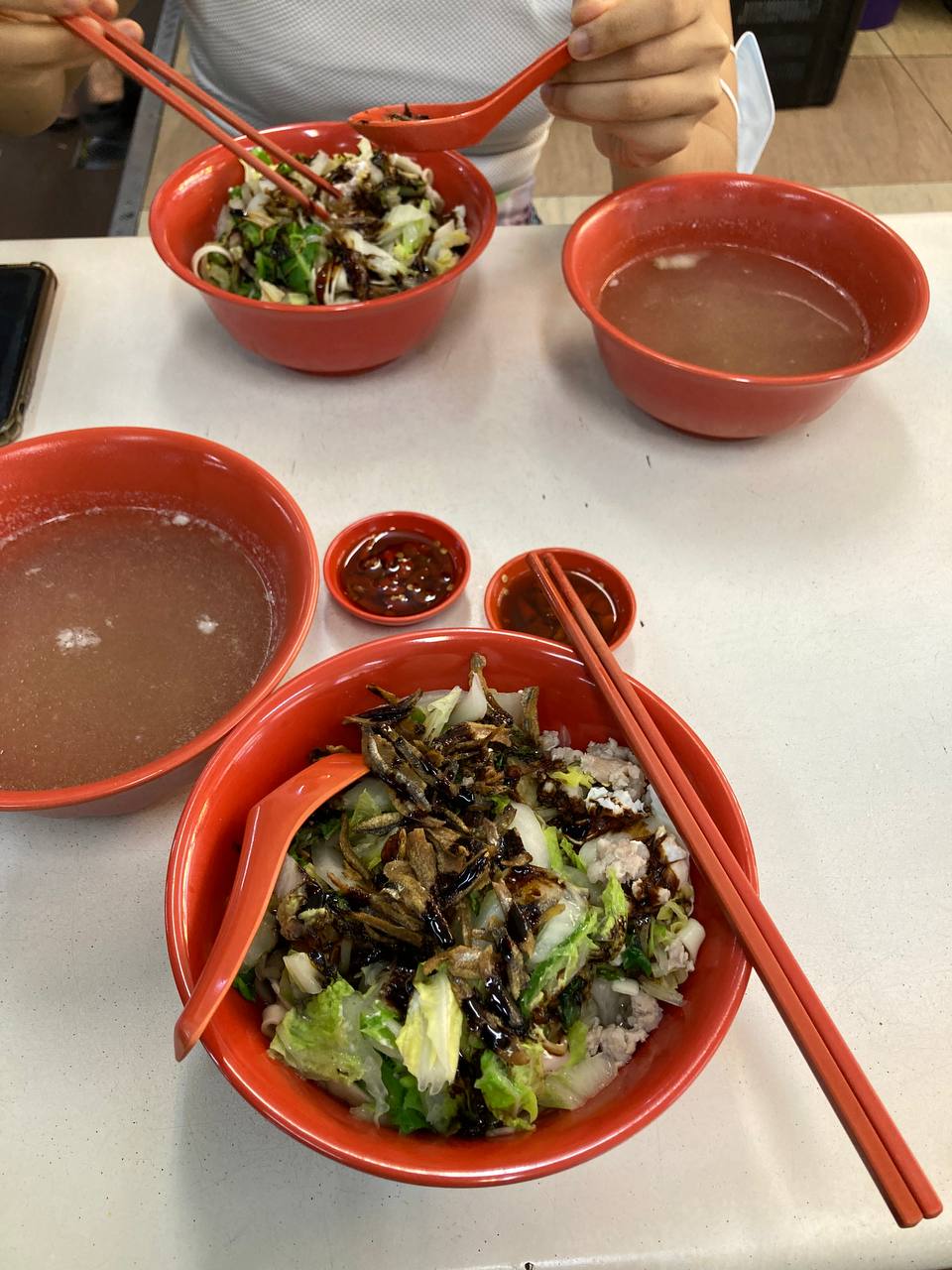 By Mothership.
By Mothership. “Shen me dou qi jia” (Everything has increased in price)
Said ban mian stall at Block 186 Toa Payoh Central – nondescript and humble – is the kind of stall you might miss if you didn’t know what to look out for.
Run by a family of five who immigrated decades ago from Fujian, China, the stall has been operating since 1999.
 Photo by Lean Jinghui
Photo by Lean Jinghui  Photo by Lean Jinghui
Photo by Lean Jinghui The 44-year-old daughter-in-law of the shop’s lady boss, surnamed Cai, revealed that the decision to increase the prices of all their menu items was actually a difficult one.
They had been worried that the price increase would result in them losing a lot of their long-time customers.
Despite the costs of ingredients having steadily increased since last November, the family had been doing their best to “tahan” (bear) the costs for the past few months by themselves.
She shared, “…but really cannot. If we continue to tahan, I think maybe we’d have no choice but to close down the shop.”
Luckily, regulars have been understanding and the number of daily orders have remained stable – for now.
According to Cai, the brunt of the increased costs came from a sharp spike in the prices of nearly all their ingredients, by about 40 per cent.
“Normally, if there’s only an increase in the cost of a few ingredients, we will cover the cost. The problem now is that all 10+ ingredients have increased in price at the same time [fish, noodles, prawn, vegetables, eggs, salt, vinegar, oil, etc].”
“Normally, if there’s only an increase in the cost of a few ingredients, we will cover the cost. The problem now is that all 10+ ingredients have increased in price at the same time [fish, noodles, prawn, vegetables, eggs, salt, vinegar, oil, etc].”
Buying less was not an option, as should they run out, customers might ask, “eh why you do business like that?”, Cai said.
“So bo bian (no choice), we buy slightly more. We still want to deliver quality food for our customers, to be better.”
“So bo bian (no choice), we buy slightly more. We still want to deliver quality food for our customers, to be better.”
 The menu at Fu Zhou Ban Mian. The dry and soup ban mian variations both cost S$4.50 now. By Lean Jinghui
The menu at Fu Zhou Ban Mian. The dry and soup ban mian variations both cost S$4.50 now. By Lean Jinghui Cai shared that they had decided to increase their food prices by 50 cents in January, up from S$4 per bowl, also in part because of higher rental costs (averaging at S$11,000 a month for them), and because it made bulk calculations more convenient.
Putting it at 30 cents would have made it difficult to calculate total costs quickly, especially when dealing with larger orders.
“We have to be fast in calculating too, especially when it gets busy. So 50 cents makes everyone’s life easier.”
Making do to take home a salary
At Old Airport Road, Zheng, 63, and her husband shared that while they had not yet increased their prices, they were going to do so.
Qiu Rong Ban Mian, previously located at Roxy Square, is best known for its soupy noodle dishes, and is well-known amongst many students and Easties.
The rich broth of the Sliced Fish Ban Mian has comforted many (including this writer) on a difficult day for just S$4.50, but Zheng shared they’d started to pre-empt customers of a price increase by about 30 cents to 50 cents per bowl, shortly after Chinese New Year.
 Prices for You Mian and Mee Hoon Kway are expected to increase by 30 cents, while the price of Ban Mian might increase by 50 cents. By Lean Jinghui
Prices for You Mian and Mee Hoon Kway are expected to increase by 30 cents, while the price of Ban Mian might increase by 50 cents. By Lean Jinghui  Photo by Lean Jinghui
Photo by Lean Jinghui  Photo by Lean Jinghui
Photo by Lean Jinghui While the pair have kept the price of their noodles at S$3 for over 10 years now, Zheng shared that they planned to increase the prices of their noodles soon, as they have not been able to make money, nor take a salary.
“You know how much the noodle flour has increased? In the past, I got one bag of noodle flour at 25kg for S$10, but now it’s S$38,” Zheng said, gesturing vigorously.
 Zheng’s kitchen. Photo by Lean Jinghui.
Zheng’s kitchen. Photo by Lean Jinghui. At one point, some of their regular customers had encouraged them to increase their prices, but Zheng and her husband shared that they had left prices unchanged as they wanted to keep their food affordable.
While being aware that their rental at a NEA-hawker centre is already cheaper than other locations, she said they decided to increase prices by a bit, as they just wanted to “get by”:
“We are old, [and] also retired in a sense, so we [decided to] just earn enough money to cover overhead costs can already.”
“We are old, [and] also retired in a sense, so we [decided to] just earn enough money to cover overhead costs can already.”
Maintaining prices, but reducing portions
For Grace, 62, however, operating a stall in the Central Business District (CBD) requires a different strategy.
Born out of a passion for cooking and bringing home-cooked food to the masses, Popo & Nana’s Delights at Maxwell Food Centre sells Eurasian and Nonya food, such as Babi Pongteh, Shepherd’s Pie, and Ayam Buah Keluak.
 Photo by Lean Jinghui
Photo by Lean Jinghui  The menu is updated daily. Photo by Lean Jinghui
The menu is updated daily. Photo by Lean Jinghui 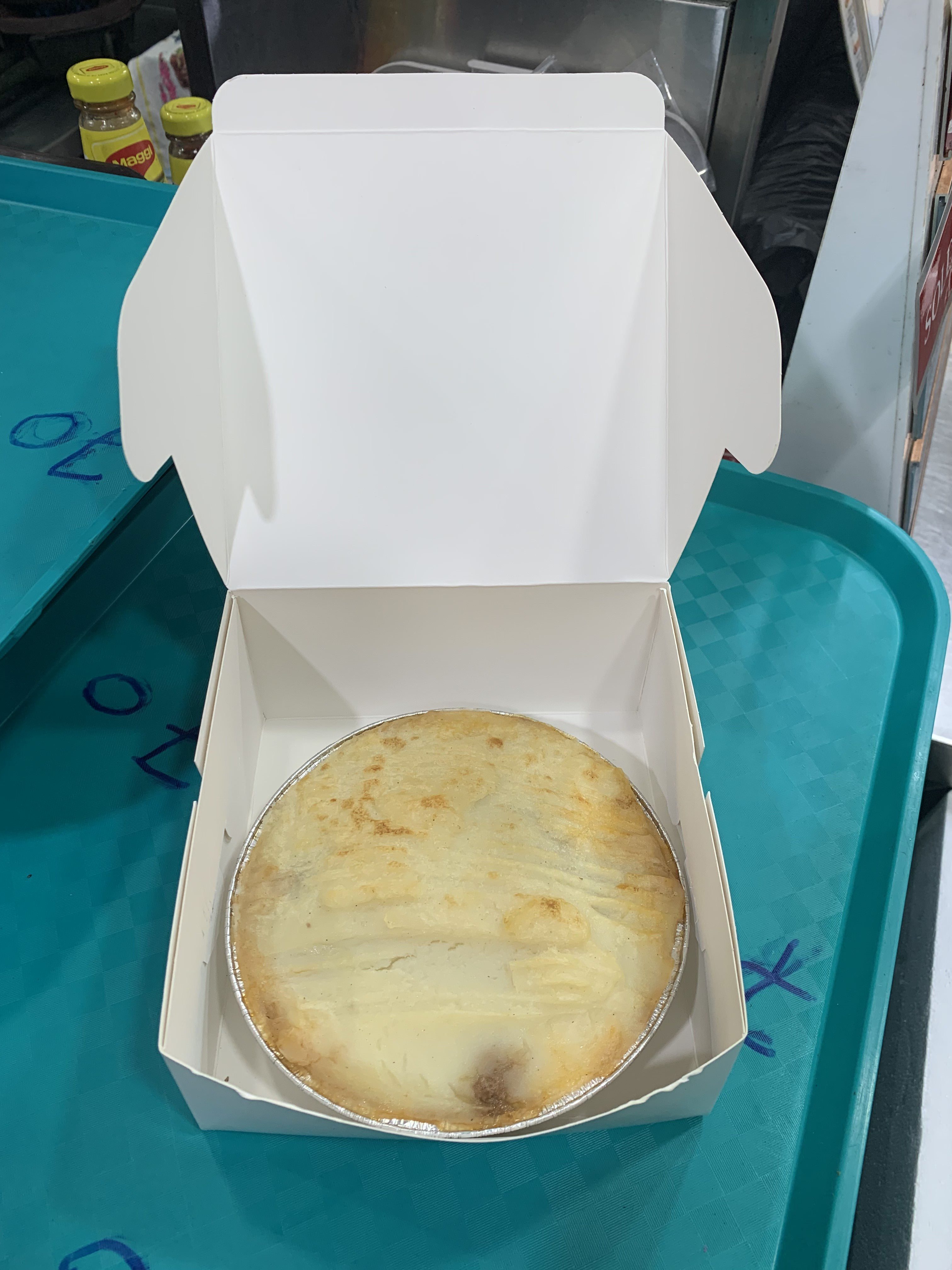 Popo & Nana’s Delights Shepherd’s Pie. Photo by Lean Jinghui
Popo & Nana’s Delights Shepherd’s Pie. Photo by Lean Jinghui While Grace has not increased her prices since opening the stall seven years ago, running the business became a challenge when Covid-19 hit.
Similarly, making enough to cover monthly overhead costs is a struggle, and sometimes, there is a deficit.
The prices of premium ingredients – like beef and pork – has increased by about S$2 per kg since last year, around 20 per cent, estimated Grace.
The cost of chilli condiments has also spiked by a full 100 per cent, and even the price of containers has gone up by 10 per cent.
 Grace preparing food for her customers. Photo by Lean Jinghui
Grace preparing food for her customers. Photo by Lean Jinghui To counter the climbing ingredient prices, Grace shared that she decided to maintain the prices of her meals at S$6 across the board, and save costs by reducing portions instead:
“Because this area in the CBD is price sensitive. If you increase your price, you might see a drop in your business. I have fellow hawkers who tried [increasing the prices], and they failed.”
“Because this area in the CBD is price sensitive. If you increase your price, you might see a drop in your business. I have fellow hawkers who tried [increasing the prices], and they failed.”
Grace added that about half her customers are senior citizens, who are generally less well off, so she prefers to keep the price status quo, and reduce the portions of some dishes.
“I offer more vegetables and cut down on the portion of the mains. I also give a complimentary soup, and it’s soup that has got red dates, pork bones etc. That compensates for the meal [smaller mains] if they dine in.”
At the stall, I noticed a steady stream of customers, and Grace noted that customers had reflected that they remain happy with the portions and thought it was generous for S$6.
 Grace and her stall. By Lean Jinghui
Grace and her stall. By Lean Jinghui Faced with a further spike in costs following the upcoming GST hike, Grace shared that she will “wait and see”, but having to call it a day is a sobering possibility.
“I think increasing the GST will affect people across the board. Many hawkers here have not raised their price and kept prices at a minimum so the public can enjoy the food.
When the GST price increases, I will probably have to increase the price and see how it goes. If it doesn’t take off, then maybe I’ll call it a day and not work anymore. No to further increasing the price, as it is very hard to sustain.”
“I think increasing the GST will affect people across the board. Many hawkers here have not raised their price and kept prices at a minimum so the public can enjoy the food.
When the GST price increases, I will probably have to increase the price and see how it goes. If it doesn’t take off, then maybe I’ll call it a day and not work anymore. No to further increasing the price, as it is very hard to sustain.”
Maintaining prices and portions for the elderly
Within Maxwell Food Centre, Mdm Soh’s daughter, who has been helping her mum run their la che mian (Rickshaw Noodles) stall for the past decade, also noted that keeping prices affordable for the elderly in the neighbourhood remained the utmost priority.
The 79-year-old stall has consistently maintained prices for the elderly, which only comprise 20 per cent of their regular customers, despite suffering a very narrow profit margin as a result.
 Photo by Lean Jinghui
Photo by Lean Jinghui 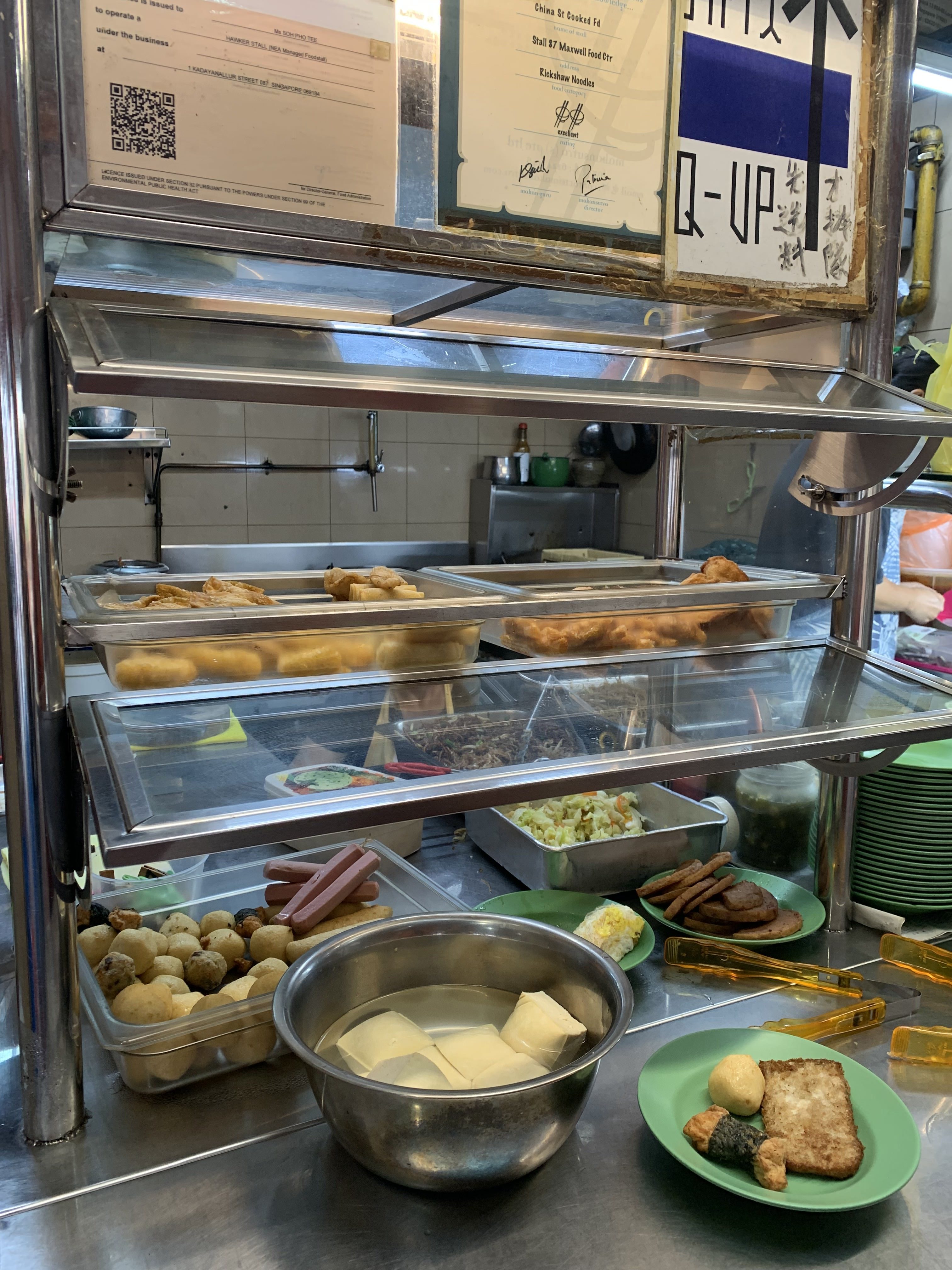 How to order: Pick your desired food items, ranging from S$0.30-S$1. Photo by Lean Jinghui
How to order: Pick your desired food items, ranging from S$0.30-S$1. Photo by Lean Jinghui 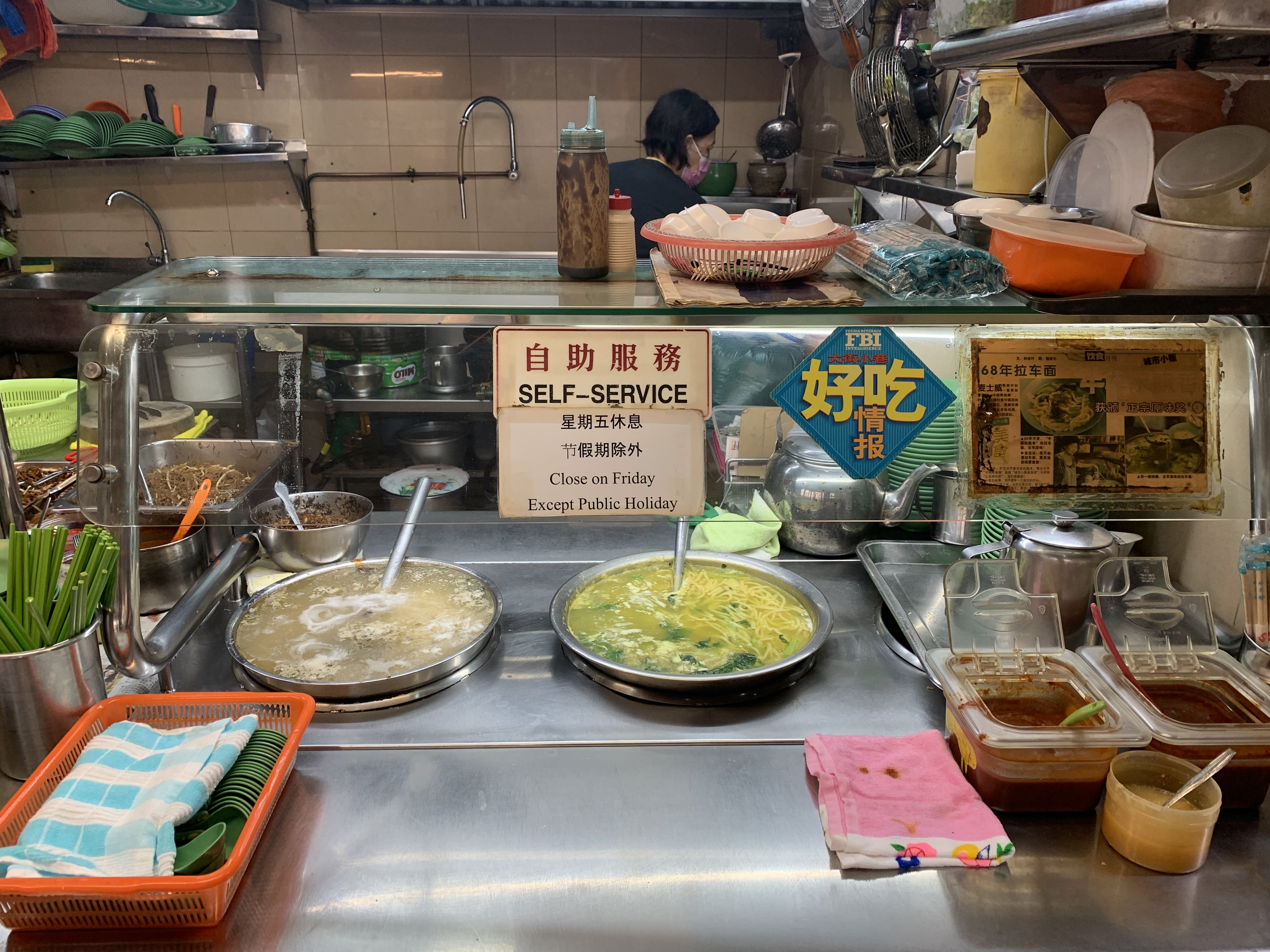 Pair it with a bowl of noodles, at S$1-S$1.50. Photo by Lean Jinghui
Pair it with a bowl of noodles, at S$1-S$1.50. Photo by Lean Jinghui Over the past five years, only their fried wonton has increased in price from 20 cents to 30 cents each, a raise implemented last year.
 The menu. Photo by Lean Jinghui
The menu. Photo by Lean Jinghui 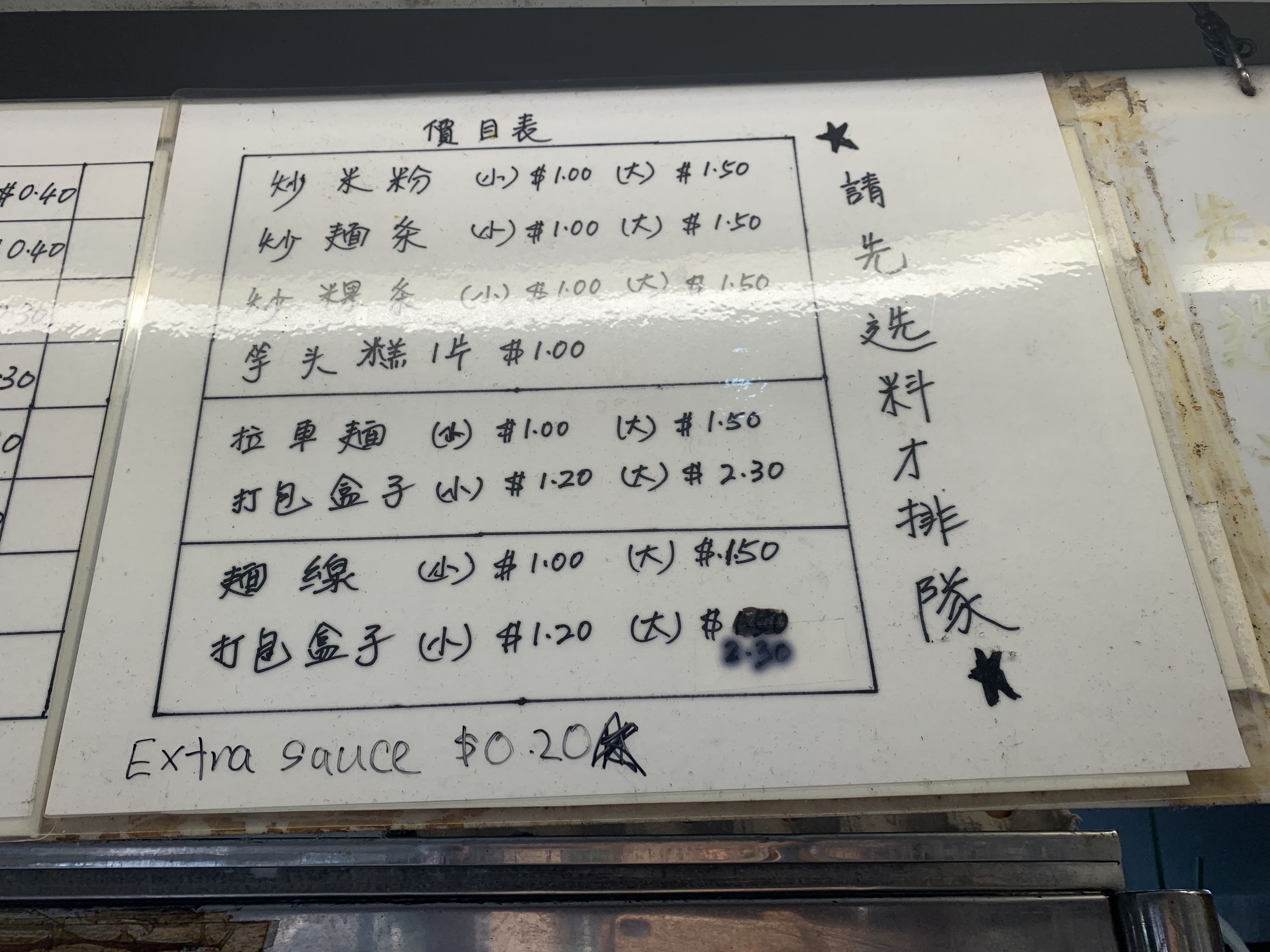 Photo by Lean Jinghui
Photo by Lean Jinghui The principle behind this is simple: To support the older customers, many of whom are Soh’s mum’s childhood friends. Pointing to the flats in the Chinatown area, Soh said:
“They have eaten from young and are now so aged, so it’s really for them that [my family] does not want to increase prices. Even though most of us [the younger generation] can afford, there are old folks who cannot afford also. Who’s gonna pay for the aged, right?”
“They have eaten from young and are now so aged, so it’s really for them that [my family] does not want to increase prices. Even though most of us [the younger generation] can afford, there are old folks who cannot afford also. Who’s gonna pay for the aged, right?”
While this has frustrated her at times, especially because Soh’s mum also insists on paying them a salary, Soh shared that she has learnt to accept it.
“We zhuan (earn) very little, just enough to cover expenses. But I told her, no point to earn so much also, since you don’t need so much money. Your whole principle is to help the old folks to survive, and we’re easy with it, so okay lor. But the business is hard to do lah, cos we depend on the young customers, and sometimes they can be very demanding, in a sense.”
Soh went on to explain that some younger customers would demand more shallots and chilli for free, and sometimes grab many pairs of disposable chopsticks, which were hidden additional costs for the family.
While all these are available in most hawker centres and stalls, Soh noted that the difference lied with other stalls charging more, at S$3.50 per bowl, while their prices remained at S$1-S$1.50 per bowl of noodles, and approximately S$0.30-S$0.50 for additional items.
“We have put extra sauce S$0.20 already. For us, it’s so little, so if you want extra chilli, extra chopsticks this kind of thing, it’s extra costs for us lor. We’re already making the minimal”.
“We have put extra sauce S$0.20 already. For us, it’s so little, so if you want extra chilli, extra chopsticks this kind of thing, it’s extra costs for us lor. We’re already making the minimal”.
All of this begs the question of how we — be it the government, or as everyday customers — can better support our favourite hawkers, who have been our pillar of affordable yet quality food for years.
Perhaps we can be more mindful of how we swipe free utensils or condiments from hawker stalls.
Or, we could proactively assure the hawkers we regularly patronise that they have our support, even if there is a price increase.
While inflation is not new, the recent spike in food ingredient and energy prices has left many hawkers with narrower profit margins, with many struggling to pay rent.
Most hawkers, however, still shared a reluctance to increase prices, either because of a fear of losing customers, or because of a wish to keep prices affordable for the masses.
Soh shared her hopes that customers could be more patient with elderly hawkers like her mum, especially when there were long queues or mistakes in calculations.
“Please be very patient, and just be more forgiving with elderly hawkers, because this is their livelihood lah.”
“Please be very patient, and just be more forgiving with elderly hawkers, because this is their livelihood lah.”
Follow and listen to our podcast here
Top images by Lean Jinghui
If you like what you read, follow us on Facebook, Instagram, Twitter and Telegram to get the latest updates.
Not the first time SIA stopped from flying into Hong Kong.
![]() February 21, 2022, 11:08 AM
February 21, 2022, 11:08 AM
Welcome back, mate.
![]() February 21, 2022, 10:37 AM
February 21, 2022, 10:37 AM
No injuries were reported, fortunately.
![]() February 21, 2022, 10:28 AM
February 21, 2022, 10:28 AM
This could have happened anywhere in Singapore.
![]() February 21, 2022, 02:59 AM
February 21, 2022, 02:59 AM
One of the four women suspected to be hostesses tested positive for Covid-19.
![]() February 21, 2022, 12:13 AM
February 21, 2022, 12:13 AM
The country has recorded 582,638 Covid-19 cases and 945 deaths in total since the start of the pandemic.
![]() February 20, 2022, 11:19 PM
February 20, 2022, 11:19 PM
Seven have been charged.
![]() February 20, 2022, 11:04 PM
February 20, 2022, 11:04 PM
She is experiencing mild cold-like symptoms.
![]() February 20, 2022, 08:49 PM
February 20, 2022, 08:49 PM
A voice from the ground.
![]() February 20, 2022, 08:25 PM
February 20, 2022, 08:25 PM
Deployment starts this month.
![]() February 20, 2022, 07:32 PM
February 20, 2022, 07:32 PM
About | Advertise with us | Contact us | We Are Hiring | Privacy policy
Copyright © 2020 Mothership. All rights reserved.